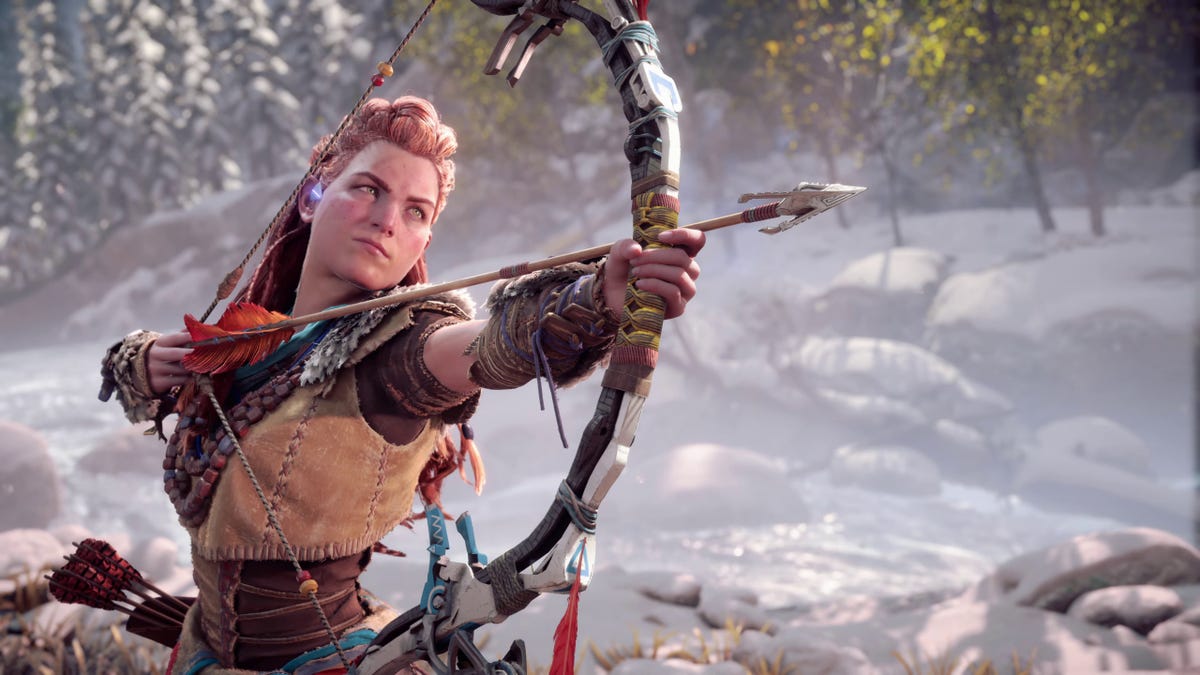Sony's Horizon Forbidden West Tree-Planting Program Feels Like a Publicity Stunt
Play a game. Plant a tree. Save the planet? Not so fast.

Aloy returns in Horizon Forbidden West, which sees her explore the remains of the west coast of North America in the far future.
Do you want to help heal the Earth's forests from the comfort of your home? For $70 you can do just that! At least, that appears to be the promise of Sony's Play and Plant program, announced on Tuesday.
The program sees the electronics and video game giant partnering with the Arbor Day Foundation, a tree-planting nonprofit, to plant 288,000 trees across three reforestation projects in the United States. The catch is that real-world trees will only be planted once a player gets through the tutorial in Horizon Forbidden West and unlocks a specific in-game trophy.
The program received a good deal of press coverage from major video games websites, with one outlet suggesting the program allows you to "save the real Earth while you save the virtual one." Another suggested that players have "the chance to do tangible good for the Earth." Comments have been largely positive, too, with many lauding Sony's initiative.
"Bout to go so hard in this game in the name of climate restoration," one tweeter said.
But a brief glance beyond the headlines reveals this is video games greenwashing at its worst.
Reforestation is an admirable goal, and the Arbor Day Foundation, which claims to have planted 500 million trees in its 50-year history, is no slouch when it comes to getting seedlings in the ground. But Sony's program gives the false impression that buying a full-priced AAA video game is the way to help fix the planet and helps cast the company's environmental actions in a positive light. It equates purchasing Horizon with doing good for the planet -- but such a simplification is grating, and when you weigh this against Sony's corporate environmental impact, the trophy-for-trees idea seems almost ludicrous.
"It's a very common, and very effective, strategy for companies to direct our focus and attention onto end users and consumers to distract us from the lack of effort from corporations," notes Ben Abraham, a sustainability researcher and consultant who has been analyzing the carbon footprint of the video game industry.
Sony has committed to a "zero environmental footprint" goal by 2050, but is still emitting almost 1.4 million tons of carbon dioxide from fossil fuel power alone, according to its 2021 sustainability report. The vast majority of this coming from energy used at Sony sites across the world.
The report also details how much carbon dioxide is emitted as a result of consumers using Sony products, like TVs and game consoles. In 2020, these emissions were 19% higher than the year prior -- and the highest they've been since 2016.
This was, the company notes, due to an increase in average TV screen size and "strong sales of the newly released PlayStation 5." The PS5 is one of the most energy-intensive consoles ever built, which means simply playing Horizon Forbidden West long enough to get the necessary trophy is actually generating carbon dioxide in the short term.
The PlayStation 5 is an energy-intensive beast.
Let's do some quick, back-of-the-envelope math: Unlocking the trophy will take about two hours of play time. If Horizon uses the same amount of energy per hour that Spider-Man: Miles Morales does (and it's likely to use more, considering it's a brand new game), then you're looking at around 400 watts of power to unlock the trophy and plant one tree. This is about the same as charging your smartphone 35 times. Now scale that up to 288,000 players and you've emitted around 90 tons of carbon dioxide to plant the trees.
That's not an extreme amount, but is it really necessary? And beyond the planting, there's also the follow-up. "There needs to be guarantees that number of trees gets planted [and] those trees get cared for and don't die," says David Ellsworth, an ecologist and forestry expert at Western Sydney University in Australia. The benefits of planting trees don't come when you unlock the trophy, but years or decades into the future. Will Sony ensure the planted trees make it to adulthood?
The tree-planting program isn't limited to the US. Sony's also partnering up with organizations in the UK, France, Germany, New Zealand and Canada for other tree-planting projects with different goals for players to reach. For instance, in New Zealand, a street artist has created Horizon artwork, and each social media share will result in one tree, with a goal of planting 1,000. And in Canada, Sony will donate one Canadian dollar to the World Wildlife Fund to rehabilitate seagrass for every copy of the game sold -- but only up to $100,000.
Which brings up another point. The first game in the series, Horizon Zero Dawn , sold over 20 million copies. Why not just donate to the organization anyway, regardless of how many copies are sold, how many trophies get unlocked, how far players progress through the game or how many social media shares a piece of art receives?
Look past the feel-good headlines and tweets, and you find little cause for celebration. Sony is making inroads into reducing its environmental impact, but the pace of progress is slow. It could have immediate and lasting impacts on the environment by rapidly decarbonizing and shifting to renewable energy to power its facilities, for instance. Instead, Sony is putting the onus on players: Go buy our game so we can plant more trees.
It doesn't deserve a trophy for that.
I reached out to Sony to clarify how tree growth, development and maintenance would be handled and whether this will be followed up by Sony in the future. I also asked whether players will know, in-game, that the trophy has contributed to the Play and Plant program. Sony didn't respond to our requests for comment.

